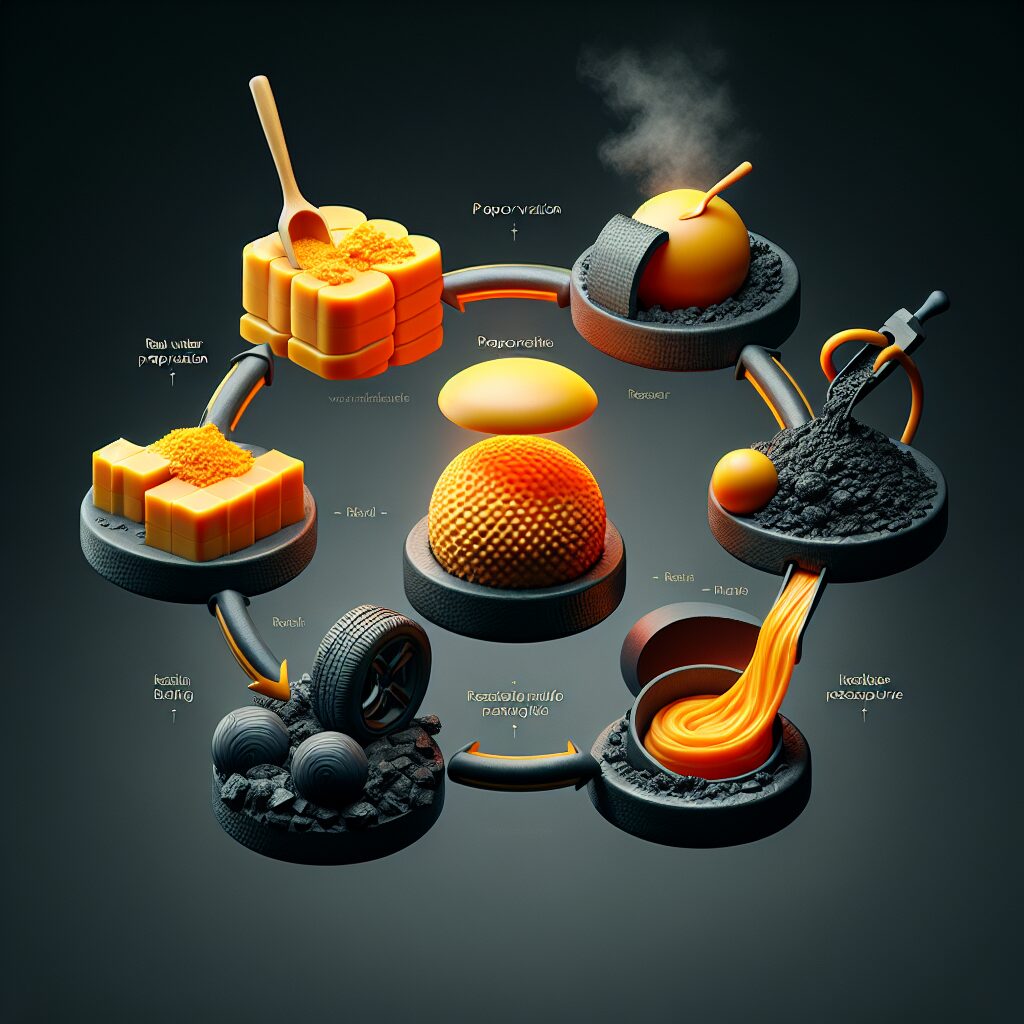Vulcanization is a crucial process in the rubber industry that involves transforming natural rubber or other related polymers into a more durable and usable material. This process was discovered by Charles Goodyear in the early 19th century and revolutionized the way rubber was used in various applications. During vulcanization, the rubber is mixed with sulfur or other chemicals and heated to high temperatures, resulting in the formation of cross-links between polymer chains. This process enhances the physical properties of rubber, making it more resistant to heat, abrasion, and aging, thereby expanding its range of applications.
One of the key impacts of the vulcanization process is the improved strength and durability it provides to rubber products. By undergoing vulcanization, rubber transforms from its natural, soft, and sticky state to a more robust and resilient material. This enhanced strength allows rubber to withstand extreme conditions, such as high temperatures, harsh chemicals, and mechanical stress. As a result, vulcanized rubber is widely used in the production of various products, including balls for sports such as soccer, basketball, and tennis. Vulcanized rubber balls have the ability to withstand the intense impacts and friction that occur during gameplay, ensuring longevity and consistent performance.
Moving forward, let’s delve into the key takeaways of the vulcanization process. We will explore the different types of vulcanizing agents and their effects on rubber properties. Additionally, we will discuss the various applications and industries that heavily rely on vulcanized rubber. By understanding the intricacies of the vulcanization process and its impact on rubber, we can gain a deeper appreciation for the versatile material that is widely used in our everyday lives. So, let’s explore the fascinating world of vulcanization and uncover the wonders it brings to the rubber industry.
Key Takeaways
1. Vulcanization is a critical process that transforms natural rubber into a more durable and functional material by chemically crosslinking its polymer chains.
2. Vulcanized rubber offers improved strength, elasticity, and resistance to heat, aging, and chemicals, making it suitable for a wide range of applications including balls, tires, footwear, and industrial products.
3. The vulcanization process involves heating raw rubber with sulfur and other chemicals, which causes a chemical reaction that forms strong sulfur bridges between the rubber polymer chains, enhancing its mechanical properties.
4. Different types and amounts of sulfur and accelerators can be used in vulcanization to adjust the characteristics of the final rubber product, such as its hardness, resilience, or flexibility, according to specific requirements.
5. The vulcanization process requires precise control of temperature, time, and pressure to achieve optimal results, and it can be carried out using various methods including compression molding, injection molding, and autoclaving.
How does Vulcanization Process Transform Rubber for Balls?
The Role of Vulcanization in Rubber Ball Manufacturing
Vulcanization is a crucial process in the manufacturing of rubber balls. It involves the transformation of raw rubber into a durable and elastic material, making it ideal for various sports such as basketball, soccer, and tennis. This section delves into the importance of vulcanization and its impact on the quality and performance of rubber balls.
Understanding the Chemistry of Vulcanization
Vulcanization is a chemical process that involves cross-linking polymer chains present in raw rubber with the help of additives, such as sulfur. This section explores the intricate chemical reactions that take place during vulcanization, resulting in the formation of strong and resilient rubber compounds.
The Vulcanization Process Step by Step
This section provides a detailed breakdown of the various steps involved in the vulcanization process for transforming rubber into balls. From raw rubber preparation to the curing process, each step is explained to give a comprehensive understanding of how rubber is transformed into a suitable material for ball manufacturing.
Importance of Temperature and Time in Vulcanization
Temperature and time play crucial roles in the vulcanization process. This section delves into the significance of maintaining specific temperature ranges and durations during vulcanization. It explains how these factors directly impact the final properties of the rubber, ensuring optimal elasticity, durability, and bounce for the resulting balls.
Quality Control Measures in Vulcanization
To ensure consistency and high-quality rubber balls, manufacturers implement stringent quality control measures during the vulcanization process. This section explores the different techniques employed to monitor and assess the rubber’s properties, such as hardness, tensile strength, and elasticity, throughout the vulcanization process.
Guides for Achieving Successful Rubber Ball Vulcanization
- What are the ideal temperature ranges for vulcanization, and how can they be maintained?
- Which additives can be used besides sulfur to enhance the vulcanization process?
- What is the impact of over-vulcanization or under-vulcanization on the rubber ball’s performance?
- What are the critical quality control tests to be performed during and after vulcanization?
- How can manufacturers optimize the vulcanization process to achieve consistent and reliable rubber ball production?
Frequently Asked Questions
1. What is the vulcanization process?
The vulcanization process is a chemical transformation method used to enhance the properties of rubber materials, such as elasticity, durability, and resistance to heat and chemicals. It involves subjecting rubber to high temperatures and adding sulfur or other curing agents to induce cross-linking.
2. Why is vulcanization important for rubber balls?
Vulcanization is crucial for rubber balls as it significantly improves their performance and functionality. The process enhances the rubber’s durability, making it more resistant to wear and tear, thereby ensuring that the balls can withstand prolonged use without easily getting damaged.
3. Are all rubber balls vulcanized?
No, not all rubber balls undergo the vulcanization process. While vulcanization is commonly used for manufacturing high-quality rubber balls used in professional sports, some lower-grade rubber balls may be made using alternative manufacturing methods that do not involve vulcanization.
4. How does the vulcanization process affect the bounce of rubber balls?
The vulcanization process greatly influences the bounce of rubber balls. By cross-linking the rubber polymer molecules, vulcanization increases the ball’s elasticity, resulting in a more lively and consistent bounce. The level of vulcanization can be adjusted to achieve the desired bounce characteristics for different types of balls.
5. Are there any environmental concerns associated with vulcanization?
Vulcanization itself is not environmentally harmful. However, the use of certain chemicals, such as sulfur, during the vulcanization process may result in emissions of pollutants. To address these concerns, modern vulcanization methods strive to minimize chemical usage and employ more eco-friendly alternatives whenever possible.
6. Can the vulcanization process be applied to other rubber products?
Yes, the vulcanization process is widely used in the production of various rubber products apart from balls. It is commonly applied to manufacture tires, hoses, seals, gaskets, and many other rubber items that require enhanced durability and performance.
7. How long does the vulcanization process take?
The time required for the vulcanization process depends on several factors, such as the type of rubber, curing agents used, and desired properties. Generally, the process can take anywhere from a few minutes to several hours in a controlled environment.
8. Can vulcanized rubber balls be recycled?
Yes, vulcanized rubber balls can be recycled to some extent. However, due to the irreversible cross-linking of rubber molecules, recycling vulcanized rubber products is more challenging than recycling non-vulcanized rubber. Specialized processes and techniques are required to break down and reuse vulcanized rubber effectively.
9. Does vulcanization affect the weight of rubber balls?
Vulcanization has a minor impact on the weight of rubber balls. Since the process mainly affects the properties of the rubber itself, the weight change is negligible. However, variations in ingredients used during vulcanization can lead to slight variations in ball weight.
10. Can vulcanization alter the color of rubber balls?
Yes, vulcanization can potentially alter the color of rubber balls. The curing agents and other chemicals used during vulcanization may have a color-changing effect on the rubber material. However, this largely depends on the specific compounds employed and the desired color specifications for the balls.
Final Thoughts
In the world of rubber manufacturing, the vulcanization process plays a vital role in transforming rubber into durable and high-performing balls. Through the cross-linking of rubber molecules, vulcanization enhances the elasticity and resilience of the material, resulting in balls that can withstand the rigors of various sports and recreational activities.
By understanding the significance of the vulcanization process and its impact on rubber balls, manufacturers can ensure the production of top-quality products that meet the demands of athletes, enthusiasts, and consumers alike. Embracing eco-friendly vulcanization methods and continuously exploring innovative techniques will further contribute to sustainable rubber ball production in the future.




